What Makes These Women Stand Out in the Mosaic World

Every so often, a group of makers comes along whose work quietly insists that we pay closer attention. This feature brings together five women who have built their practices around mosaic, a medium that grows through fragments, rhythm and steady handwork. Their studios are scattered across different countries and climates. Yet, their approaches share a commitment to materials that carry history and to processes that reveal meaning slowly rather than all at once.
These are the artists who work with stone, glass and ceramic in ways that speak to place, craft and daily observation. Agnieszka Kwiatkowska builds her mosaics one measured gesture at a time, shaped by traditional training and a life lived between Poland, the Netherlands and the Spanish coast. Poulina Nikolaeva treats each material as if it has a story to offer, arranging pieces so they form surfaces with their own rhythm and pace. Catherine van der Woerd follows the changing light of Nova Scotia, creating glass-on-glass works that shift quietly as the sun moves across a room. Caroline Jariwala brings a long-standing practice rooted in teaching, community work and picassiette, turning discarded crockery into patterned surfaces full of character and history. And Sarah Fishbein draws from mid-century romance comics, translating charged scenes and expressive faces into stained glass panels that react to the light in which they sit.
Together, these five artists demonstrate the breadth and generosity of a mosaic. This introduction opens the way into their stories, methods, and studio worlds, offering a look at how they build images, atmospheres, and conversation pieces piece by piece.
Agnieszka Kwiatkowska@ aurora_mosaics
Agnieszka Kwiatkowska works from the Valencian coast, shaping mosaics that invite quiet attention. Her pieces are crafted from fragments of stone, glass, and marble, each meticulously set by hand with traditional Italian tools. She follows the slow rhythm of tesserae meeting one another, letting small elements build toward a sense of presence and connection.
Originally from Poland, she trained at the Scuola Mosaicisti del Friuli before founding Aurora Mosaics in Amsterdam. Her practice has carried her through different countries, yet her focus has remained steady: exploring how careful, patient craft can shape the atmosphere of a space and the way we move through daily life. Whether creating commissioned pieces or intimate works for contemplation, she transforms raw materials into arrangements that hold memories, quiet rituals, and a sense of continuity with the natural world.
Her online journal and Hammerlist provide glimpses into her process, her studio life in Spain, and her ongoing fascination with mosaic history, from ancient chariot scenes to small, surviving fragments that span centuries. Among the five women featured here, Agnieszka brings a steady devotion to the long tradition of mosaic making and to the simple act of noticing what is already present in the world around us.
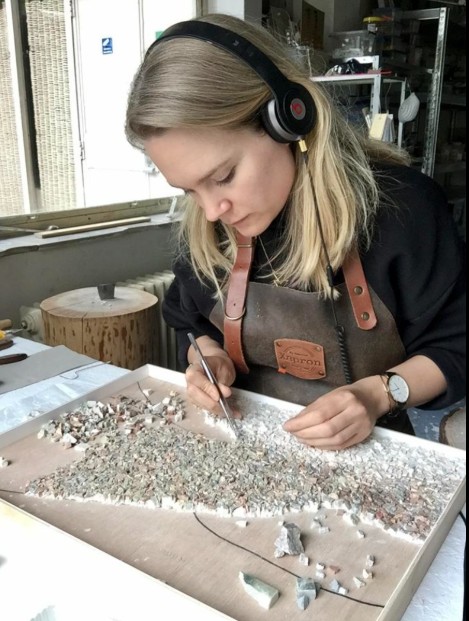

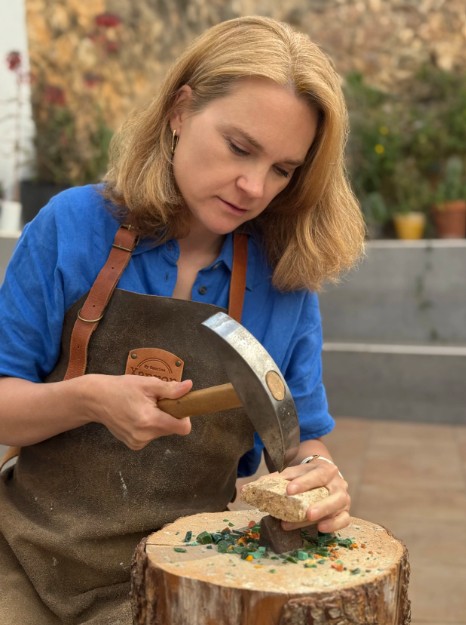
Poulina Nikolaeva @poulina.mosaic
Poulina Nikolaeva works with mosaic as a tool for synthesis — she gathers disparate fragments of glass, stone and ceramic. She arranges them into surfaces that hold their own rhythms and logic. On her Instagram profile, she describes herself as a “mosaic artist & teacher” (in both English and Russian) and notes that she creates custom mosaic pieces.
In her studio, she treats each material as if it has its own story to tell. A piece of coloured glass might signal a wave of motion, a shard of marble might anchor a quiet corner, a ceramic fragment might call attention to texture and light. The result is work that gives shape to what might otherwise go unnoticed: transitions of tone, echoes of pattern, subtle shifts across a surface.
Nikolaeva gives herself the licence to explore scale from compact, framed panels to larger installations. She invites the viewer to slow down, lean in, look at edges and junctions, to see how many tiny decisions accumulate into something coherent. At the same time, she teaches others how to engage with tesserae, helping a new generation of makers become comfortable with precision, patience and material intuition.
Her practice is rooted in craft without nostalgia; she respects traditional mosaic methods while exploring how they can speak to us today. For collectors, public spaces, and design commissions, her work bridges the realms of architecture and fine art, as well as installation and intimate objects.
She is one of five women mosaic makers we are proud to feature, bringing fresh perspective and a quiet intensity to a medium that thrives on assembly and transformation.


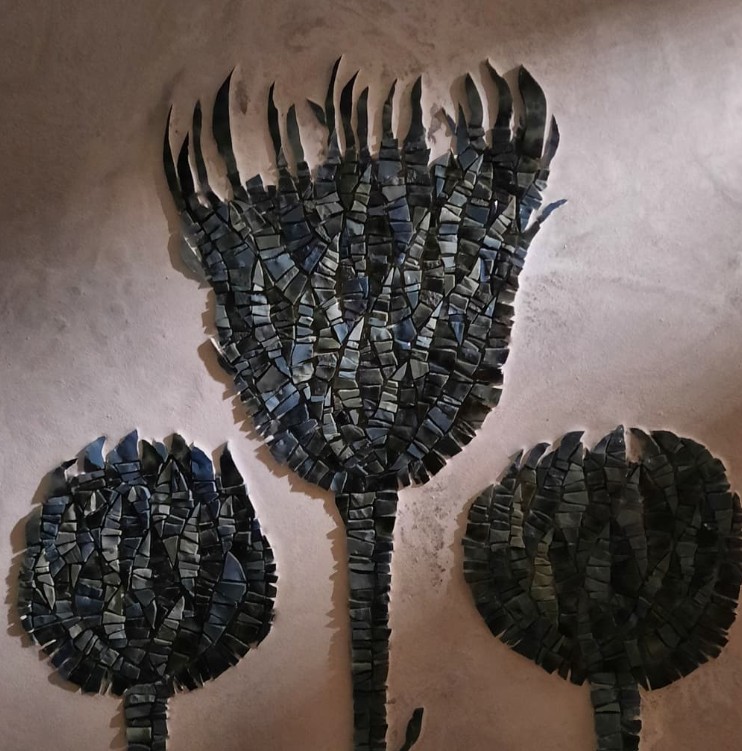
Caroline Jariwala @ mangomosaics
Caroline Jariwala has spent many years developing a practice that seamlessly transitions between painting, teaching, community work, and mosaic. Her Mango Mosaics evolved from her interest in picassiette, a technique that utilises damaged or discarded crockery. She looks for pieces that others have already given up on and turns them into patterned surfaces that carry colour, texture and a sense of reuse that feels both practical and poetic.
Her background as a teacher and visiting lecturer comes through in the way she approaches community projects. She has worked in schools, galleries, and public settings since the early 1990s, guiding groups through processes that require patience, decision-making, and attention to simple materials. Before she became known for mosaics, she created paintings that linked Italian Renaissance imagery with Hindu themes, a pairing that shaped the foundation of her visual language.
Caroline has exhibited her work widely since the mid-1980s, and it appears in several national archives and directories. She has also taken on commissions in both public and private settings, often building pieces that respond to a place or story. What sets her apart is the way she sources her materials. She chooses chipped plates, discontinued tiles, and second-hand ceramics, treating them as valuable rather than disposable. The pieces she creates feel grounded in this ethic, reminding viewers that beauty can grow from whatever is at hand.
Including Caroline in this feature brings attention to someone who has spent decades building connections between making, teaching and community. Her mosaics carry the traces of many hands and many stories, shaped through the steady practice she has maintained across education, health and creative projects in the UK and beyond.


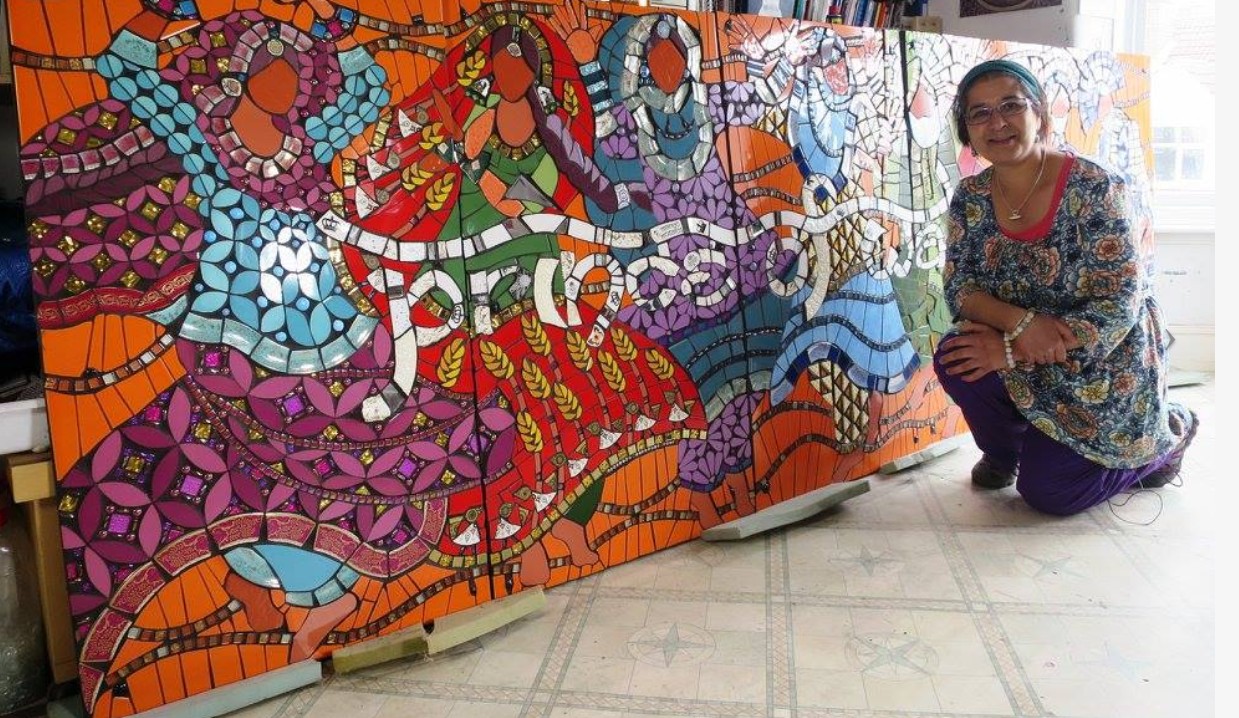
Sarah Fishbein @sarahfishbeinmosaics
Sarah Fishbein has spent more than two decades working with images, first through photography and video and now through glass mosaics that draw from the bold world of mid-century romance comics. Her shift into Pop Art Mosaics feels like a natural continuation of her curiosity about how stories are told. She brings the expressive faces, charged moments, and emotional drama of the 1950s and 1960s into a present-day conversation, using glass as her leading voice.
Her method combines stained glass and mosaic in a way she has developed through steady experimentation. Each piece begins as a sketch inspired by comic frames and ends as a panel built through careful cutting and placement. The work often speaks to themes that matter to her in daily life, such as relationships, women’s experiences, LGBTQ stories and the challenges and joys of being human. Light plays a key role in her pieces, and she selects glass that changes throughout the day so the work feels alive and responsive to its surroundings.
Sarah approaches each mosaic as a story built piece by piece. She draws inspiration from moments that strike her in the news or in her everyday life, letting those impressions guide her. Viewers often notice the emotional charge in the faces she chooses and the way the glass carries that tension. Her mosaics sit comfortably between the nostalgia of old comics and the honesty of present-day conversations.
She lives in New Jersey with her husband, Chuck, who is also her business partner, their daughter, Ellie, and their Cockapoo, Cooper. Her home life and studio practice seem closely linked, creating an environment where memory, humour, frustration, tenderness, and observation all find their way into her work.
Including Sarah in this feature brings forward an artist who is not afraid to revisit the past while speaking clearly to the present. Her mosaics carry a sense of time, place, and emotion that feel both familiar and renewed through the slow, steady work of glass.
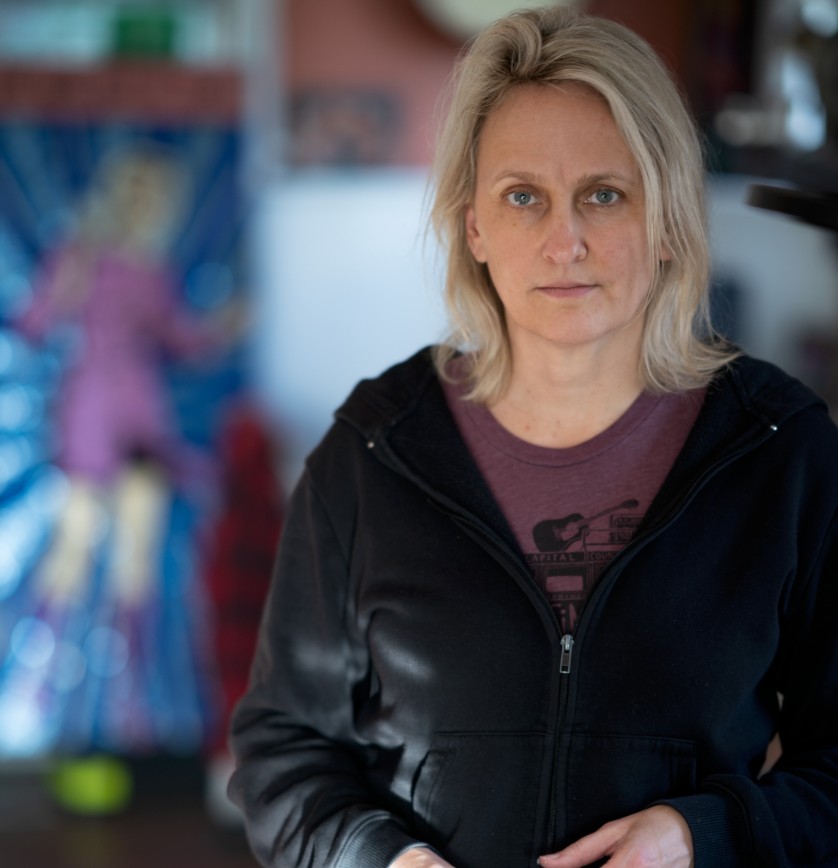


Catherine van der Woerd @ mosaicartist1
Catherine van der Woerd works mostly in glass on glass mosaics, a method she shares often on her Instagram. Her posts show a steady rhythm of cutting, arranging and adjusting pieces of stained glass until the surface begins to suggest movement. Dragonflies, shifting skies and seaside colours appear again and again in her work, most likely shaped by the summers she spends in Harbourville, Nova Scotia. The light there guides much of what she creates. When the sun passes through her panels, the glass casts small pools of colour that change with the time of day, giving each piece a quiet sense of motion.
What you notice first is how carefully she listens to her materials. She does not rush them. She lets the curves, edges and tones guide the structure of a piece. Her windows and panels often begin as a simple shape, but as she builds them, they gain a gentle flow that feels closely tied to the place where she works. Her workspace is filled with cutoffs of glass, tools lined up within easy reach and unfinished panels that show the early stages of her thinking.
Including Catherine in a feature on five women working in mosaic feels fitting. She shows how a patient approach and close attention to natural surroundings can shape the direction of a piece. Her mosaics invite the viewer to linger, to move a little to the left or right, to see how the glass shifts when the light does. There is an honesty to her process that comes through clearly, both in her finished panels and in the way she shares her studio moments online.
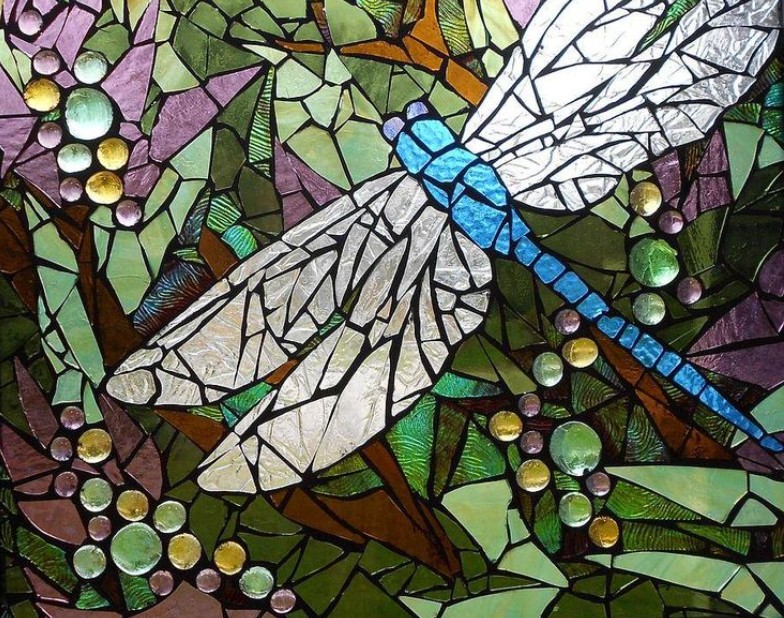

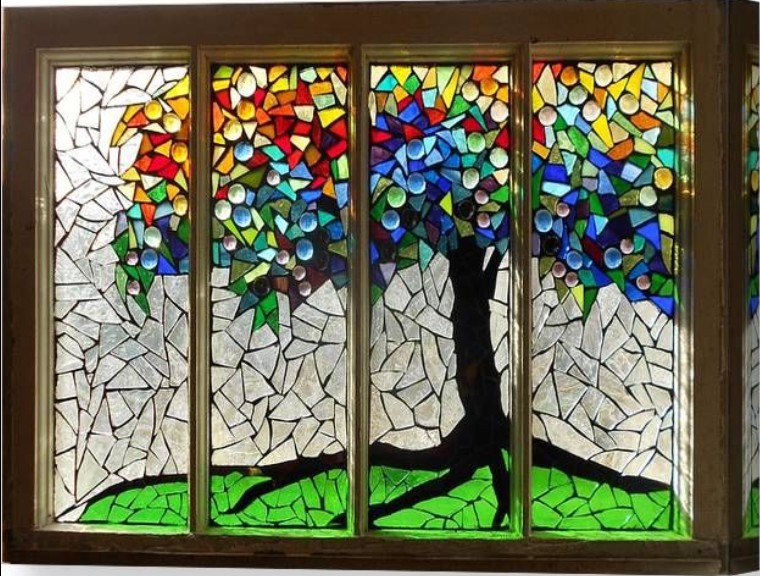
what ties these five women together is not a single theme, but the steady way they show up for their materials and their ideas. Spending time with their work feels a bit like sitting in each of their studios for a moment and watching how decisions unfold. Some pieces start with a sketch, others with a stack of chipped plates, others with the way morning light comes through a window. Yet each artist brings a pace and attention that gives their mosaics a life that can’t be rushed.
What lingers after reading about them is a sense of how mosaic fits into everyday routines. It’s there in the long afternoons sorting glass, in the conversations sparked during community workshops, in late-night edits to a panel that just isn’t settling yet, and in the quiet satisfaction that comes when the final piece clicks into place. Their work moves between homes, public spaces, coastal towns, busy cities and small studios, proving that mosaic doesn’t belong to one type of maker or one kind of setting.
These five artists remind us that building with fragments is not simply about fitting pieces together, but about paying attention to the small things that shape a larger picture. Their mosaics encourage us to pause, look a little longer and notice how much can grow from small, deliberate choices. It’s a fitting close to a feature that celebrates not only what these women create, but the thoughtful, steady way they bring their work into the world.
